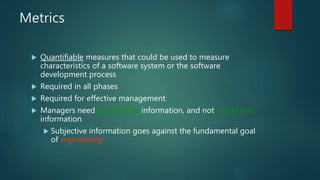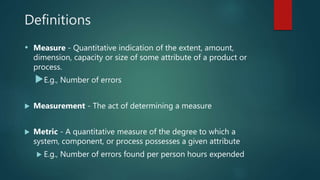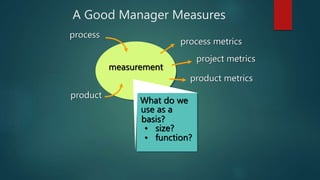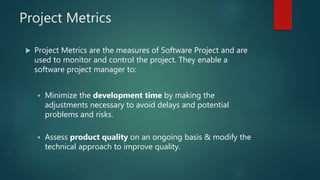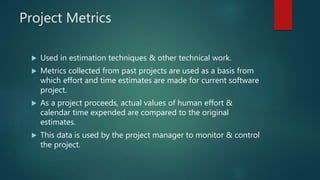software metrics(process,project,product)
- 1. G.H. PATEL COLLEGE OF ENGINEERING & TECHNOLOGY SUBJECT : SOFTWARE ENGINEERING(2160701) DEPARTMENT: COMPUTER PREPARED BY: RUCHITESH MALUKANI-160110107026 NARSINGANI AMISHA-160110107031 GUJARAT TECHNOLOGICAL UNIVERSITY
- 2. Questions How big is the program? Huge!! How close are you to finishing? We are almost there!! Can you, as a manager, make any useful decisions from such subjective information? Need information like, cost, effort, size of project.
- 3. Why Measure Software? Determine the quality of the current product or process Predict qualities of a product/process Improve quality of a product/process
- 4. Metrics Quantifiable measures that could be used to measure characteristics of a software system or the software development process Required in all phases Required for effective management Managers need quantifiable information, and not subjective information Subjective information goes against the fundamental goal of engineering
- 5. Measurement Measurement is fundamental to any engineering discipline Software Metrics - Broad range of measurements for computer software Software Process - Measurement can be applied to improve it on a continuous basis Software Project - Measurement can be applied in estimation, quality control, productivity assessment & project control Measurement can be used by software engineers in decision making.
- 6. Definitions • Measure - Quantitative indication of the extent, amount, dimension, capacity or size of some attribute of a product or process. E.g., Number of errors Measurement - The act of determining a measure Metric - A quantitative measure of the degree to which a system, component, or process possesses a given attribute E.g., Number of errors found per person hours expended
- 7. Definitions Indicator – An indicator is a metric or combination of metrics that provide insight into the software process, a software project or the product itself. Direct Metrics: Immediately measurable attributes (e.g. line of code, execution speed, defects reported) Indirect Metrics: Aspects that are not immediately quantifiable (e.g. functionality, quantity, reliability) Faults: Errors: Faults found by the practitioners during software development Defects: Faults found by the customers after release
- 8. Why Do We Measure? To indicate the quality of the product. To assess the productivity of the people who produce the product To assess the benefits derived from new software engineering methods and tools To form a baseline for estimation To help justify requests for new tools or additional training Estimate the cost & schedule of future projects Forecast future staffing needs Anticipate and reduce future maintenance needs
- 9. A Good Manager Measures measurement What do we use as a basis? • size? • function? project metrics process metrics process product product metrics
- 10. Process Metrics majority focus on quality achieved as a consequence of a repeatable or managed process statistical SQA data error categorization & analysis defect removal efficiency propagation from phase to phase reuse data
- 11. Process Metrics Measuring the outcomes: Errors Defects Productivity Effort Time Schedule conformance Measuring the characteristics of specific task: Effort and time spent performing the umbrella activities and generic SE activities
- 12. Factors Affecting Software Quality
- 13. How to Measure Effectiveness of a Software Process We measure the effectiveness of a software process indirectly We derive a set of metrics based on the outcomes that can be derived from the process. Outcomes include Errors uncovered before release of the software Defects delivered to and reported by end-users Work products delivered (productivity) Human effort Calendar time etc. Conformance to schedule
- 14. Project Metrics Project Metrics are the measures of Software Project and are used to monitor and control the project. They enable a software project manager to: Minimize the development time by making the adjustments necessary to avoid delays and potential problems and risks. Assess product quality on an ongoing basis & modify the technical approach to improve quality.
- 15. Project Metrics Used in estimation techniques & other technical work. Metrics collected from past projects are used as a basis from which effort and time estimates are made for current software project. As a project proceeds, actual values of human effort & calendar time expended are compared to the original estimates. This data is used by the project manager to monitor & control the project.
- 16. Project Metrics Used by a project manager and software team to adapt project work flow and technical activities. Metrics: Effort or time per SE task Errors uncovered per review hour Scheduled vs. actual milestone dates Number of changes and their characteristics Distribution of effort on SE tasks
- 17. Product Metrics focus on the quality of deliverables measures of analysis model complexity of the design internal algorithmic complexity architectural complexity data flow complexity code measures (e.g., Halstead) measures of process effectiveness e.g., defect removal efficiency
- 18. Metrics Guidelines Use common sense and organizational sensitivity when interpreting metrics data. Provide regular feedback to the individuals and teams who have worked to collect measures and metrics. Don’t use metrics to appraise individuals. Work with practitioners and teams to set clear goals and metrics that will be used to achieve them. Never use metrics to threaten individuals or teams. Metrics data that indicate a problem area should not be considered “negative.” These data are merely an indicator for process improvement. Don’t obsess on a single metric to the exclusion of other important metrics.
- 19. Types of Software Measurements Direct measures Easy to collect E.g. Cost, Effort, Lines of codes (LOC), Execution Speed, Memory size, Defects etc. Indirect measures More difficult to assess & can be measured indirectly only. Quality, Functionality, Complexity, Reliability, Efficiency, Maintainability etc.
- 20. Normalization of Metrics To answer this we need to know the size & complexity of the projects. But if we normalize the measures, it is possible to compare the two Normalization: compensate for complexity aspects particular to a product For normalization we have 2 ways- Size-Oriented Metrics Function Oriented Metrics
- 21. Size-Oriented Metrics • Based on the “size” of the software produced LOC - Lines Of Code KLOC - 1000 Lines Of Code SLOC – Statement Lines of Code (ignore whitespace) Typical Measures: Errors/KLOC, Defects/KLOC, Cost/LOC, Documentation Pages/KLOC
- 22. Function-Oriented Metrics Based on “functionality” delivered by the software Functionality is measured indirectly using a measure called function point. Function points (FP) - derived using an empirical relationship based on countable measures of software & assessments of software complexity
- 23. Qualities of a good metric simple, precisely definable—so that it is clear how the metric can be evaluated; objective, to the greatest extent possible; easily obtainable (i.e., at reasonable cost); valid—the metric should measure what it is intended to measure; and robust—relatively insensitive to (intuitively) insignificant changes in the process or product.



